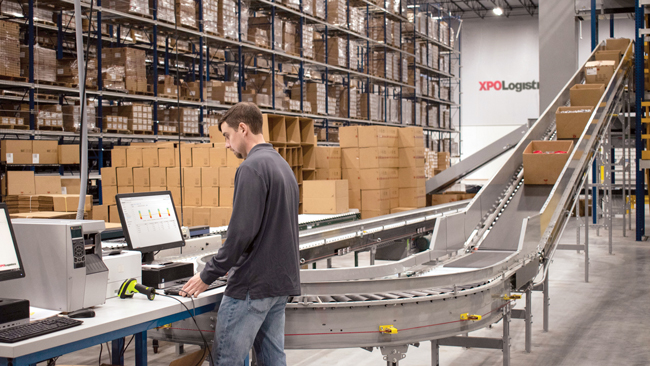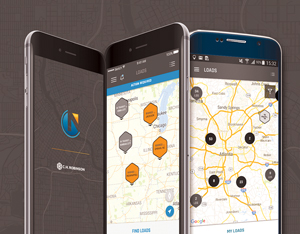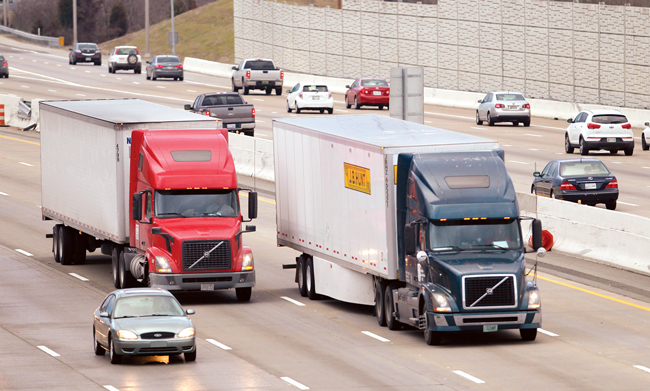
Employees at C.H. Robinson. (Photo courtesy of Steven A. Smith)
When financier Brad Jacobs launched his bid to consolidate the logistics industry in 2011, he set into motion a process that continues to reshape the industry today.
But now there are other business strategies in play with the potential to disrupt the business and spur a new era of growth for companies that can offer a broad range of services and have the capability to adapt quickly to changing market conditions.
While many firms are pursuing mergers and acquisitions as a way to grow their businesses and increase market share, others are working to create large networks of shippers and carriers and applying technology to make freight transactions more efficient.
Some of the companies doing this are C.H. Robinson Worldwide, the world’s largest freight brokerage firm; J.B. Hunt Transport Services, the nation’s largest intermodal freight service provider; and XPO Logistics, the company that employs Jacobs as CEO and ranks No. 1 on the Transport Topics Top 50 list of largest logistics companies in North America.

A worker in an XPO Logistics warehouse. (XPO Logistics)
Other companies are attempting to parlay their expertise in freight procurement and distribution management to provide a one-stop shop for shippers to outsource transportation and logistics services. Firms pursuing this approach include Transplace Inc., GlobalTranz Enterprises and Echo Global Logistics.
Meanwhile, companies that specialize in warehousing and distribution, such as Kenco Logistics and DSC Logistics, are moving aggressively to expand their services to include transportation management, freight brokerage and e-commerce fulfillment services.
At the same time, investors continue to pour money into digital freight startups that are trying to automate many of the services provided by transportation intermediaries, such as load matching, asset tracking and freight payments. These new players include Uber Freight, Convoy and Transfix.
While it remains to be seen how each of these strategies will play out, their influence already is being felt across the third-party logistics industry, according to company executives and analysts interviewed by Transport Topics.
“Disruptive change now underway in the transportation marketplace will likely accelerate,” declared Atlee Valentine Pope, CEO of consulting firm Blue Canyon Partners. “In response, traditional service providers will need to review their current roles and responsibilities and explore ways to create additional value in order to remain relevant and sustainable.”

Pope
Pope doesn’t see one business model dominating the market, but she believes it will be essential for logistics service providers to know intimately what their customers will require and to be “positioned accordingly.”
And while some shippers also might move their capabilities in-house, others will not, Pope noted.
“When markets are disrupted, the winners are usually those who can continue to create value,” she explained. “So organizations with scale will remain ahead of the game and so will sharp, agile, tech-oriented newbies. Those in the middle of the pack will likely have a harder time facing this changing landscape.”
What that means to longtime logistics industry practitioner Paul Thompson, founder and chairman of Transportation Insight, is that more consolidation is coming and he plans to be part of it.

Thompson
“My goal is to be a market leader in enterprise logistics,” Thompson said in a recent interview in a historic hosiery factory in Hickory, N.C., that he recently renovated and turned into a modern workplace for several hundred employees.
Thompson, a former sales executive at Carolina Freight Carriers Corp., started CHTL Trucking in the mid-1990s and grew it to a 500-truck fleet, then went on to launch Transportation Insight in 1999 to help shippers control transportation costs by sourcing capacity, auditing freight payments and providing advice on managing supply chains.
The company currently handles more than $5 billion in transportation-related spending for about 1,500 clients in mostly the manufacturing and retail industries.
My goal is to be a market leader in enterprise logistics.
Paul Thompson, Transportation Insight
As Thompson sees it, the next 10 years will be “harvest time” for his business as shippers increasingly turn over responsibility for transportation to third-party logistics managers that can offer the best combination of knowledge, technology and access to capacity.
After receiving an injection of capital from private equity firm Gryphon Investors in September, Thompson said his firm is poised to move quickly to boost its market presence by adding new freight services to its business offerings.
The first move occurred in December when Gryphon and Transportation Insight joined forces to acquire a majority stake in Nolan Transportation Group, a multimodal freight brokerage firm based in Atlanta.
Although the company was growing rapidly on its own, Harold Baron, CEO of NTG and a former managing director with the Blackstone Group, said partnering with Transportation Insight has many benefits.

Baron
“We now have a much broader suite of services,” Baron told TT. “We offer a transactional product and when combined with Transportation Insight’s managed transportation offering, we can provide a complete solution. And we can better cater to our customer’s supply chain needs.”
Future acquisition targets for Transportation Insight include firms involved in intermodal and refrigerated freight transportation, U.S.-Mexico cross-border freight movement and e-commerce fulfillment, the last of which Thompson describes as the “biggest white board part” of the company’s future.
According to Thompson, it once was considered taboo for a firm that provides transportation management to also own a freight brokerage or trucking operation because of potential conflicts of interest. Attitudes have changed, in part, because technology allows greater visibility of transactions, and shippers have come to see having access to more capacity as an advantage in controlling costs.
Another change in the market, industry executives said, is that some shippers are moving away from using multiple logistics companies, relying instead on a relationship with one company to manage the entire supply chain.
“I see more outsourcing now than I have in the 15 years I’ve been in this business,” said Vincent Chiodo, chief commercial officer at Transplace, which is based in Frisco, Texas.

Chiodo
Much of the shift that is occurring now is due to what happened in 2018 when a shortage of truck capacity resulted in a sharp escalation in freight rates and, perhaps more importantly, an increase in the number of rejected loads as freight carriers and drivers shunned lower-priced freight and cut back on driving time due to the implementation of new electronic logging requirements to better enforce driver hours-of-service limits.
“Companies are looking for help,” Chiodo said.
For many shippers, the disruption in freight movement last year had ripple effects throughout the supply chain and cut into profits.
With more than $8.5 billion in freight under management, Transplace is one of the largest players in the transportation management space and, like Transportation Insight, is looking to add complementary freight services while expanding its use of technology to provide shippers with more visibility for loads and better control over the supply chain.
“The future,” Chiodo said, “is looking at people and processes.”
Renee Krug, CEO of GlobalTranz Enterprises in Scottsdale, Ariz., said she sees 2019 as “the year of technology.”
A former executive at Swift Transportation, Krug said transportation management is GlobalTranz’s fastest-growing business and, as a consequence, the company is investing heavily in software and analytics to help shippers save money on transportation and to respond to new service requirements driven by e-commerce and shifting global trade policies.
“We’re also focused on becoming more of a value-added partner,” Krug said. “We want to help customers understand how to automate transactions and how to become more efficient for their customers.”
Mergers and acquisitions are another part of the company’s strategy.
“Size and scale helps,” Krug explained. “We want to be able to consolidate bids and bring that higher volume to truckload carriers. We’re also looking at ‘transformative’ deals in which we get into something new.”
While consolidation is a powerful trend in the market, it comes with some risk as companies must try to squeeze transportation efficiencies from an ever-larger pool of freight, said Jim Rice, deputy director for the Center for Transportation and Logistics at the Massachusetts Institute of Technology.
“You have to feed the beast,” Rice said of the need for larger companies to keep their networks fully utilized.
For many companies, the battleground for controlling freight will be waged in digital, automated marketplaces like the ones being created by well-funded technology startups such as Uber Freight and Convoy.
More established players in the transportation industry also are building technology-enabled freight networks.
C.H. Robinson Worldwide created a platform called Navisphere that connects 200,000 shippers and carriers in North America and elsewhere.

C.H. Robinson’s Navisphere app.
“We’re executing truckload, less-than-truckload, intermodal, ocean, air, customs managed services, parcel and other services with over $20 billion in freight under management,” Andrew Clarke, the company’s chief financial officer, said in a recent earnings call with investment analysts. “Robinson is a digital leader in the logistics space and it’s a big and growing space, but we’ve been in it the longest. We’re spending as much, if not more, than anybody else.”
Clarke said the impact of tech startups in the market is negligible so far.
“We have over 120,000 [shipper] customers, and there’s probably 119,000 of those customers that aren’t, or haven’t been, doing business with the digital startups,” he said.
Similar networks offered by J.B. Hunt and XPO Logistics appear to be gaining traction as well.
J.B. Hunt 360 has processed $550 million in freight transactions in just over a year since it was launched. In November, the company struck a deal with Project44 to provide real-time shipment information to participants in the network by using electronic connections to carriers and devices used by truck drivers to log their hours.
“We were not sure what the reception would be to a digital platform for matching carriers and shippers,” said Kirk Thompson, chairman of J.B. Hunt, in describing the J.B. Hunt 360 program in a letter to shareholders. “But, we were sure that it would be a great improvement on the manual applications currently in place.”

J.B. Hunt has partnered with Project44 to provide real-time shipment information. (John Sommers II for Transport Topics)
At XPO, the company’s digital freight marketplace, called XPO Connect, has more than 14,000 carriers registered and the number of digital bids submitted by drivers seeking loads has doubled in the fourth quarter compared with the third quarter, according to Matt Fassler, chief strategy officer.
“We attribute much of the success to our counteroffer feature, which negotiates automatically based on real-life market conditions,” Fassler said in a recent earnings call with investment analysts. “This has led to better gross margins.”
Representatives of Uber Freight, Convoy and Transfix all declined to disclose the number of transactions they are currently handling.
However, Uber Freight recently said its network has expanded to 30,000 carriers. The company’s platform is designed primarily for owner-operators and small fleets operating 10 or fewer trucks.
Uber Freight also is expanding internationally. The company said it will begin operations in Europe this year, starting in the Netherlands.

The Uber Freight app. (Aether Films)
Convoy said it tracks the percentage of loads that are automatically matched as a way of measuring its progress. In February, the company said it achieved a 100% match rate for a number of key freight markets, including Seattle, Portland and Los Angeles on the West Coast, as well as Chicago, New York and Atlanta. Nationwide, the match rate was 95% compared with about 25% when the company started in 2016.
Transfix, launched in 2013, has received $78.5 million in venture capital and claims to be working with Anheuser-Busch, Unilever and Target to procure freight hauling capacity through an automated network.
CEO Drew McElroy, in an interview with Forbes magazine, said he believes the company can reach $1 billion in revenue by 2021.
For MIT’s Rice, the idea of using technology to automate load matching may not recognize the reality that overall capacity is limited by the number of drivers.
Popular ride-sharing apps Uber and Lyft, for example, draw from a pool of freelance drivers that oftentimes work interchangeably with both firms, he points out.
Drivers therefore are likely to sign up for as many marketplaces as possible, but will end up using only the ones that prove to be the most efficient in terms of finding loads and ease of use.
Ultimately, what’s important, Rice said, is to create a model that is flexible and can respond to market forces.
Logistics industry researcher Satish Jindel of SJ Consulting Group said he also takes issue with the idea that technology alone will be a source of disruption for the transportation and logistics industry.
“I don’t know of any big company that isn’t using technology,” he said.
Jindel points out that despite the enormous amount of money invested in startups, the value of those companies pales in comparison to traditional freight brokerage firms. “It’s not even the tail of the dog,” he said.
“3PLs of the future will be the ones that leverage information at every point in the supply chain … and matching that data so that you can take out wasted hours and get better capacity utilization by using fewer trucks to handle more freight.”
Original Source: https://www.ttnews.com/articles/how-consolidation-and-freight-networks-are-disrupting-logistics-landscape
